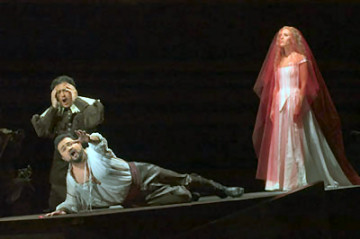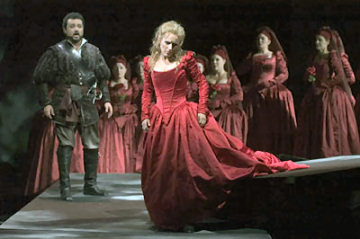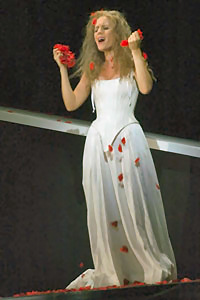‘Lucie
de Lammermoor’
Glimmerglass Opera Festival: Glimmerglass Opera Orchestra and
Chorus, soloists, cond. Beatrice Jona
Affron,
August
1st 2005
(ME)

Glimmerglass
Opera is Glyndebourne without the snobbery and sometimes simply
stupid productions: it is all the other Glyndebourne wannabees
without their pretensions and
amateurism, and it occupies a stupendously beautiful
setting near the glorious Lake Otsego in New
York
State. What more could you ask? Well, you get to hear emergent
young stars trained by an enterprising ‘Young American Artists
Program,’ you experience a hall which has exceptional acoustics
(in its warmth and intimacy I would characterize it as an operatic
Wigmore) you eat and drink very well in a smoke-free environment,
and if you’re a Literature or Baseball buff, you have Cooperstown
just down the road, famed not only as the home of ‘the first
great American novelist,’ James Fenimore
Cooper (whose novel ‘The Deer slayer’ first used the word ‘Glimmerglass’
to describe Otsego Lake, explaining that it was the original
Indian name for it) but of course also as the location of the
Baseball Hall of Fame.
In
its 30th season, Glimmerglass has continued its tradition
of presenting four totally new productions each year, and the
overall polish, level of organization and high standards are
a glowing tribute to a festival which was founded by a group
of local residents with the sole aim of bringing opera to their
little community – how wonderfully egalitarian and somehow truly
American this is, in contrast to the reason for both the foundation
and continuation of, say, Glyndebourne. I would have loved to
have covered the whole season, which included a most enticing
‘Death in Venice’ featuring the excellent tenor William Burden
and the promising countertenor John Gaston, and an equally tempting
‘Così’ with Sanford Sylvan as Alfonso,
but other commitments prevented me from attending all but one
performance.

This
presentation of the version of ‘Lucia’ prepared by Donizetti
for Paris performances in 1839 was noteworthy for its lead soprano,
Sarah Coburn, a past member of the Glimmerglass Young American
Artists’ Program, and for its conductor, the director of the
Pennsylvania Ballet company. Looking at their future plans,
I would say that both are at present under-parted, and I would
hope that wider prospects will beckon for them after this production.
Given the mediocrity of what we’re often asked to praise in
terms of dramatic sopranos over here, and the scarcity of anything
resembling a very good female conductor, both ought to be positively
besieged by promoters once next season gets under way. Both
are young – the soprano in her twenties, the conductor in her
thirties, and stunningly good-looking, but don’t let that fool
you, for here is a high dramatic soprano who moves more like
a sylph than a sea-lion and who sings with elegant precision
even in a ‘Mad’ scene, and a conductor who looks more like a
model than the usual frump which characterizes the females of
the species and directs with a rare blend of forcefulness and
sensitivity.
Coburn’s
Lucie was an ideally vulnerable, fragile
figure, her characterization easy to appreciate since one did
not have to waste time wondering if she would reach the notes:
she has them, and to spare, and they are voiced with clarity,
sensitivity to language (French diction was exemplary overall
– if a bunch of mostly under-30 Americans in what most British
opera snobs would probably regard as a desperately Hicksville
little place can please a native French speaker then why is
it so difficult for UK opera companies?) and idiomatic assurance.
The lack of a confidante for Lucie
in this version (the original’s Alisa having been lost) places
extra spotlight on the heroine, since the chorus as used in
this production does not really fulfil any dramatically supporting
role for her, so it is even more essential to cast from strength
in this role – and you could hardly ask for a more confident
and committed performance.

The
quality of her singing was not quite matched by the rest of
the cast, although Raúl Hernández, as Edgar, wields
a powerful tenor voice with some impressively confident, ringing
high notes – his tone lacks focus however and is rather thin
in the middle of the range, and his stage presence is as yet
rudimentary. Earle Patriarco is more
confident on stage and his Henri glowered impressively as well
as singing with style; the other parts were less strongly cast,
Chad A Johnson in particular not yet ready for the role of Arthur
although his very light tenor does show promise.
In
orchestral terms, the music positively glowed; tempi were brisk
yet sympathetic to the singers – Glimmerglass allows for the
conductor to be on site during the full rehearsal period, and
it shows – and there was some really fine playing by the strings
and especially the woodwind. Affron’s
is a name to watch, and if she’s still with the Pennsylvania
Ballet two years from now I will be very surprised indeed –
no criticism meant of course towards that excellent company.
This
is an opera which I’ve always felt is crying out for a modern
reworking – perhaps not exactly with Lucie
and Edgar slugging vodka martinis as they vigorously engage
in orgies with a couple of noble Stags, but perhaps just something
more in the Jonathan Miller style: I have fond memories of Sutherland
and Kraus singing in the Italian version at Covent Garden, and
the present production did not add a great deal to that, although
it must be said that there was also nothing to detract from
the music – and far better that, than the ludicrous attempts
at spurious ‘contemporaneity’ which
infect some of our stages. The lighting, by the established
and award-winning Christopher Akerlind,
was remarkable in that it managed to suggest gloom and doom
whilst remaining highly vivid, and the production in general,
by Lillian Groag, was clear, gently
evocative of Scotland (mists, clouds, much red, a woman dressed
as a deer…) without any embarrassing Walter-Scottery,
and served to allow the singers to do their job without any
daft posturings or physical contortions.
In
short, a wonderful afternoon spent at a superbly organized festival
in glorious surroundings, with the added joys of ‘discovering’
an outstanding soprano and conductor. I shall be making every
effort to attend the whole season next year, and I suggest you
do the same.
Melanie
Eskenazi
Pictures © George Mott/Glimmerglass Opera
Photo 1 - Earle Patriarco as Henri, Raúl Hernández as Edgard and Sarah Coburn in the title role of Donizetti's Lucie de Lammermoor at Glimmerglass
Opera.
Photo 2 - Raúl Hernández
as Edgard and Sarah Coburn in the
title role of Donizetti's Lucie de
Lammermoor at Glimmerglass Opera.
Photo 3 - Sarah Coburn in the title role of Donizetti's Lucie de Lammermoor at Glimmerglass
Opera.





